Sale, Victoria
Sale is a city situated in the Gippsland region of the Australian state of Victoria. It had an estimated urban population of 15,135 as of June 2019.
| Sale Victoria | |||||||||||||||
|---|---|---|---|---|---|---|---|---|---|---|---|---|---|---|---|
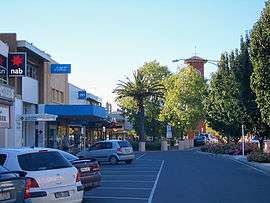 View of the Sale city centre toward the mall | |||||||||||||||
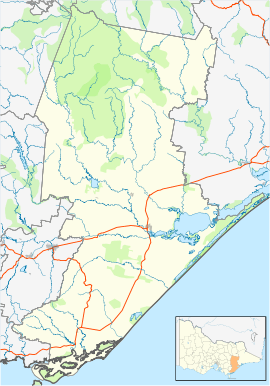 Sale Location in Wellington Shire, Victoria | |||||||||||||||
| Coordinates | 38°06′S 147°04′E | ||||||||||||||
| Population | 15,135 (2019)[1] | ||||||||||||||
| • Density | 331.9/km2 (859.6/sq mi) | ||||||||||||||
| Established | 1851 | ||||||||||||||
| Area | 45.6 km2 (17.6 sq mi)[2] (2011 urban) | ||||||||||||||
| Location | |||||||||||||||
| LGA(s) | Shire of Wellington | ||||||||||||||
| State electorate(s) | Gippsland South | ||||||||||||||
| Federal Division(s) | Gippsland | ||||||||||||||
| |||||||||||||||
History
The Aboriginal name for the Sale area was Wayput.[3] Two famous Gippsland explorers, Paul Strzelecki and Angus McMillan, passed through the immediate area around 1840. The first white settler was Archibald McIntosh who arrived in 1844 and established his 'Flooding Creek' property on the flood plain country which was duly inundated soon after his arrival.
In the 1840s, drovers heading south to Port Albert crossed Flooding Creek and were confronted with the difficult marsh country around the Thomson and Latrobe rivers. A punt operated across the Latrobe River until a toll bridge was erected. A Post Office named Flooding Creek opened here on 30 September 1848 being renamed, somewhat belatedly, as Sale on 1 January 1854.[4]
The first town plots went on sale in 1850. When the new settlement was gazetted in 1851 it was named 'Sale' — a tribute to General Sir Robert Sale, a British army officer who won fame in the first Afghan war before being killed in battle in India in 1845. An SBS TV documentary "Afghanistan: The Great Game" [5] claims that it is actually named after his wife, Lady Florentia Sale (1790–1853), who wrote a famous journal of her experiences during the First Afghan War which became a best seller in the 1840s and was serialised in The Times (UK) and possibly in Australia. Certainly, her letters to her husband were enthusiastically published in Australian papers.[6]
The town greatly benefitted from the 1851 gold rush at Omeo as it was situated on the Port Albert to Omeo route and was an important base for the goldfields, until the arrival of the railways. It was also an important service centre for East Gippsland and the Monaro Plains of New South Wales. A building boom took place c. 1855–65.
In 1863 the population of Sale reached 1800 and it became a borough. The courthouse opened the following year. Shops, hotels and offices spilled over into Raymond Street and the first Anglican Church was erected on the site now occupied by St Anne's and Gippsland Grammar School. The Gippsland Times newspaper was established in 1861 while the first Star Hotel and the Criterion Hotel were built in 1865.
St Paul's Cathedral is the cathedral church of the Anglican Diocese of Gippsland in Australia. The cathedral building, built in 1884, is a double-storey building with a rectangular footprint and is constructed of red brick and slate roofing.
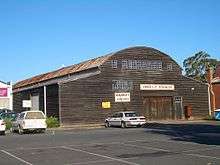
In terms of access, the first reasonable road from Melbourne arrived in 1865 and Cobb and Co established a rough-and-ready 24-hour coach service linking Melbourne and Sale. The Latrobe Wharf was built in the 1870s and two hotels emerged to exploit the new centre of activity. It was located near the present swing bridge although little is left.
Anthony Trollope visited Sale in 1872. Writing of the experience in Australia and New Zealand (1873) he spoke of the town's "innumerable hotels" and concluded from his impressions that the Aborigines had little chance of surviving as a race. The children's author Mary Grant Bruce was born in the town in 1878.
A two-storey post office, with clock tower, was built in 1884 (it was demolished in 1963). HM Prison Sale was completed in 1887 and it operated for 110 years until it was replaced by a private Fulham Correctional Centre. The building has since been demolished, with only part of the large brick fencing still remaining. The site remained empty until 2014 when construction of the new Sale Police Station commenced there. It opened in March 2015.
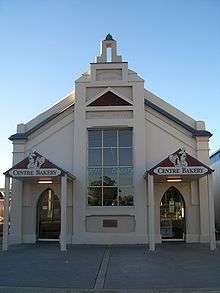
Other landmarks in the town include Our Lady of Sion Convent and the Criterion Hotel. The former was designed by architects Reed, Smart and Tappin and built 1892–1901. Assembly halls and dormitory rear wing were added in 1938; the residential wing was added in 1953. The building is listed on the Register of the National Estate.[7] The Criterion Hotel was built in 1865. It originally had a two-storey timber verandah, but this was replaced by a cast iron verandah between 1880 and 1900. It is considered "one of the most impressive hostelries in Victoria" and is listed on the Register of the National Estate.[8] The Criterion Hotel closed in 2006 and its rapidly deteriorating condition caused local concern that it would be demolished. However, the site was subsequently purchased by a Traralgon-based developer who had previous expertise in restoration of commercial buildings. The Criterion received a complete rebuild in 2010/11 with the external heritage facade and verandah fully restored. It re-opened as a hotel, function venue and restaurant early in 2013.
With the growth of shipping on the local waterways and the Gippsland Lakes (and the establishment of a railhead at Sale in 1879) schemes emerged to develop Sale as a port. The construction of the Sale Canal (complete with turning circle) duly commenced in the 1880s, thereby linking the town via the Thomson River and the Gippsland Lakes to the open sea. It was completed in 1890. Other elements were the Sale Swing Bridge, completed in 1883, a high wharf, and a launching ramp which still exists in the heart of the city. However, neither the bridge nor the canal created the desired surge of trade and the depression of the 1890s soon engulfed the town. Sale became a town in 1924 and a city in 1950.
In World War II, the West Sale RAAF base was the landing site of 2 Japanese Mitsubishi Zeros.
Sale has seen much development and redevelopment in the past decade, one example being the multimillion-dollar redevelopment of the city's Port of Sale.[9]
Geography
Climate
Sale has a moderate oceanic climate (Cfb) made up of warm summers, mild autumns and springs and cool winters. Sale records 595.9 mm (23.4 in) of measurable precipitation per year, making it drier than the nearby state capital, Melbourne. The wettest month is November whilst the driest is July. At 54.8 days, it gets more clear days than Melbourne (48 days).
| Climate data for East Sale Airport | |||||||||||||
|---|---|---|---|---|---|---|---|---|---|---|---|---|---|
| Month | Jan | Feb | Mar | Apr | May | Jun | Jul | Aug | Sep | Oct | Nov | Dec | Year |
| Record high °C (°F) | 44.6 (112.3) |
44.4 (111.9) |
40.4 (104.7) |
35.9 (96.6) |
28.3 (82.9) |
23.2 (73.8) |
24.0 (75.2) |
28.3 (82.9) |
33.0 (91.4) |
34.7 (94.5) |
39.8 (103.6) |
40.8 (105.4) |
44.6 (112.3) |
| Average high °C (°F) | 25.4 (77.7) |
25.3 (77.5) |
23.5 (74.3) |
20.3 (68.5) |
16.8 (62.2) |
14.3 (57.7) |
13.8 (56.8) |
15.0 (59.0) |
17.0 (62.6) |
19.2 (66.6) |
21.2 (70.2) |
23.4 (74.1) |
19.6 (67.3) |
| Average low °C (°F) | 12.8 (55.0) |
13.2 (55.8) |
11.4 (52.5) |
8.6 (47.5) |
6.3 (43.3) |
4.2 (39.6) |
3.2 (37.8) |
4.1 (39.4) |
5.6 (42.1) |
7.5 (45.5) |
9.5 (49.1) |
11.3 (52.3) |
8.1 (46.6) |
| Record low °C (°F) | 3.9 (39.0) |
3.3 (37.9) |
2.8 (37.0) |
−1.7 (28.9) |
−4.2 (24.4) |
−4.5 (23.9) |
−6.6 (20.1) |
−5.6 (21.9) |
−3.7 (25.3) |
−1.0 (30.2) |
1.3 (34.3) |
2.2 (36.0) |
−6.6 (20.1) |
| Average precipitation mm (inches) | 45.5 (1.79) |
41.7 (1.64) |
48.8 (1.92) |
48.1 (1.89) |
52.0 (2.05) |
46.0 (1.81) |
41.0 (1.61) |
46.0 (1.81) |
52.2 (2.06) |
58.1 (2.29) |
62.7 (2.47) |
54.0 (2.13) |
595.9 (23.46) |
| Average precipitation days | 8.5 | 7.7 | 8.9 | 10.3 | 12.1 | 13.4 | 14.0 | 14.7 | 14.4 | 14.0 | 12.0 | 10.3 | 140.3 |
| Average afternoon relative humidity (%) | 51 | 53 | 54 | 56 | 63 | 66 | 64 | 59 | 59 | 58 | 56 | 54 | 58 |
| Mean monthly sunshine hours | 237.3 | 217.5 | 192.1 | 172.3 | 138.4 | 124.3 | 141.3 | 161.0 | 178.0 | 197.8 | 211.9 | 223.2 | 2,195.1 |
| Source: [10] | |||||||||||||
Economy and infrastructure
Oil and gas

After oil was discovered offshore in 1965, the town experienced a boom period when it became the service and residential base of the Esso-BHP oil and gas exploration and development program. The unprocessed oil and gas are pumped through 700 kilometres (430 mi) of undersea pipes to Longford, 19 kilometres (12 mi) south of Sale. There the hydrocarbons are removed and used to produce LPG and ethane. The gas is piped to Melbourne and the oil to Westernport Bay and thence to Geelong and Altona from where it is shipped interstate and overseas.
Esso's Longford gas plant was the site of a major explosion on 25 September 1998 which killed two employees and crippled the state's gas supplies for a period of two weeks. Previously, Sale was significant as an office centre for the Esso corporation but these operations were relocated around 1990, leaving only a gas processing facility in nearby Longford.
Shopping
Sale's main shopping precincts are Gippsland Centre and adjacent Raymond St Mall. Most other shopping style stores including clothing, music and food can be found along Raymond St, known to be the main street of Sale.
Facilities
Fulham Correctional Centre, a medium security prison, is in the locality of Fulham to the west of Sale.
Media
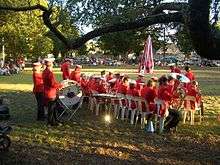
Newspapers
Sale's local newspaper is The Gippsland Times founded in 1861. Two issues are published each week; subscribers pay for only one issue per week. Its readership spans Wellington Shire, from north of Dargo to south of Port Albert, and to the west of Rosedale and east of Munro. The paper is part of the Fairfax Rural Media network of newspapers.
Television
Commercial television networks Prime7, WIN and Southern Cross Ten all broadcast into Sale from the Latrobe Valley transmitter at Mt Tassie with all stations being based in Traralgon. All three channels have local commercials placed on their broadcasts and WIN TV also broadcasts a local news bulletin. Both national public broadcasters, ABC (ABC1) and SBS (SBS ONE) are broadcast into Sale as well.
New channels broadcast by all the networks in addition to the ones listed above are available on the digital service called Freeview (Australia) to viewers in Sale and the Gippsland / Latrobe Valley region. These channels include ABC2, ABC3, ABC News 24, SBS Two, One HD, Eleven, 7Two, 7mate, GEM and GO!.
Radio
Traralgon based Ace Radio commercial stations — TRFM and Gold 1242 both cover Sale. The Gold 1242 AM 1242 kHz transmitter is located in Myrtlebank between Maffra and Sale. Most ABC stations are rebroadcast locally as well as the local ABC Gippsland station that is based in Sale. Community Radio station Life FM is based in Sale.
On 30 May 2009 the ABC's national network Triple J held their annual One Night Stand concert in Sale. 12,000 people attended the event at the Sale Football Ground.
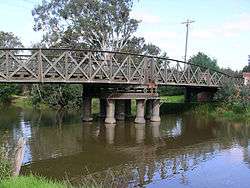
Transport
Sale is linked by rail to Melbourne and Bairnsdale by the Bairnsdale V/Line rail service that stops at the local railway station. Until 1983 the station was situated in the centre of town,[11] on what is now the Gippsland Centre shopping centre.
The city is located at the junction of the Princes Highway and the northeastern end of the South Gippsland Highway.
Sale Swing Bridge
The Sale Swing Bridge is the only one left in the world that can swing around 360° and featured in the Australian film noir movie "The Tender Hook".
Culture
Events and attractions

The March Labour Day weekend witnesses the Marley Point Overnight Yacht Race which is the longest overnight inland yacht race in the world. It begins near Sale and concludes at Paynesville, some 60 km away.
A Sale attraction is Lake Guthridge, a low lying retention basin, which features a park for children, barbecues, and a walking trail around the lake and car parking facilities. Prior to refurbishment in the mid-1990s Lake Guthridge suffered a blue-green algae problem that resulted in widespread fish mortality until local joggers and nearby residents complained of the associated stench causing council to act. Lake Guthridge has never been used as a food source.
A significantly superior natural waterway of historical significance is the aforementioned Port of Sale (previously Sale Canal), the original inspiration for the early town's original name - Flooding Creek. The Canal connects to other local rivers and lakes, leading eventually to Lakes Entrance, an oceanside tourist resort situated near a managed, naturally occurring channel connecting the Gippsland Lakes to Bass Strait. Once steam boats and ocean-going craft were able to journey from Lakes Entrance to Sale, arriving at the docks at Sale to ferry passengers and goods from Eastern Victoria, although its success in such a role was short lived.
In recent years, a grassroots effort helped to persuade the local council to invest in restoration of the foreshore and to protect against erosion. Prior to the rise of Common Carp as the predominant fish species due to nutrient overload from agricultural runoff, Sale Canal featured pristine waters and native fish stocks. The Sale Regatta is run yearly on a long straight section of the canal headed towards Longford. Visitors to Sale are usually unaware of the Canal, including its restoration, due to roadside views of it being blocked by the former Esso corporation headquarters, half of which is commercially let office space and the other half having been re-developed into a multimillion-dollar Library and Art Gallery.
Sale is home to the Gippsland Art Gallery, a major Victorian public gallery. The gallery presents a diverse exhibition program of contemporary, modern and historical exhibitions, with a focus on the landscape of South Eastern Australia. The gallery holds a collection of nearly 1,000 artworks, with a small selection on permanent view.
A fishing contest is held at Lake Guthridge every Easter and the Sale Music Festival at Gippsland Grammar School in June. The Sale Art Exhibition is held over August and September, while the Sale show falls in October.
As a tribute to the late King George V, an elm-lined section of the Princes Highway is named King George V Avenue.
On 30 May 2009, Sale hosted Triple J's One Night Stand at the Sale Football Ground. Sale also has a strong underground music scene; events are held every few months and attract scores of young people.
Every Saturday, Sunday, and Monday, the Gippsland Armed Forces Museum is open, featuring local military and significant history and artifacts. In recent times it has moved from its original location on Punt Lane to a bigger building at West Sale Airfield, after the original building was purchased for development works. The museum pays homage to the 13th Australian Light Horse Regiment, among others.
Sports
Australian rules football, basketball and cricket are the most popular sports in Sale. The Gippsland Regional Sports Complex hosts many other sports including basketball, Association rules football, volleyball, badminton, table tennis, indoor soccer, aerobics, group fitness and gym.
The city has two Australian rules football teams, Sale, competing in the Gippsland Football League and Sale City, who compete in the North Gippsland Football League.
It is home to the Sale Sonics, a representative basketball team that competes in the Country Basketball League and is renowned for developing many elite Australian rules football and National Basketball League sporting stars including Billy Hughes, Jason Gram, Scott Pendlebury, Dylan McLaren and Rhys Carter .
Sale United Football Club enters teams in the Gippsland Soccer League (GSL) competitions. Sale United FC was formed as the Sale City Soccer Club in 1974. It has remained in the Gippsland competition each year since the Club's first season and has had a number of promotions and relegations during the term. Sale United is the only recognised soccer club in the Shire, but this was always the case. Representative clubs from Yarram, Bundalaguah, and the RAAF East Sale base also competed in the GSL.
The city is the home to two field hockey clubs in the East Gippsland Hockey Association. The Sale Hockey Club fields teams in juniors mixed under 13s, under 15s, and under 18s along with two women's teams, the Sale Cygnets and the Sale Swans, along with one open team. The under 18s and open teams were champions in the 2008 season. The Wurruk Greyhounds are the Sale district's second hockey team, located in the satellite town Wurruk.
Sale has a horse racing club, the Sale Turf Club, which schedules around 21 race meetings a year including the Sale Cup meeting in October.[12]
The Sale Greyhound Racing Club, operating since 1936, holds regular meetings.[13]
Golfers play at the course of the Sale Golf Club on Longford-Rosedale Road in neighbouring Longford.[14]
Sale is also home to a baseball club whose baseball diamonds are located at Stephenson Park. There are both junior and senior teams competing in the Latrobe Valley Baseball Association.
Sale is also home to the Sale City Rollers who are the region's first amateur Co-ed flat track roller derby league and are located at the Henebery Pavilion at the Sale Showgrounds.
Notable people
Arts
- Annemieke Mein, Dutch born Australian textile artist
- Danny Spencer, Musician
- Mary Grant Bruce, Children's Author [15]
Sport
- Ashley Delaney, Olympic swimmer
- Pauline Frasca, Olympic rower
- Alan Morrow, former Australian rules footballer with St Kilda Football Club and 1966 premiership player
- Shane Birss, former Australian rules footballer with St Kilda Football Club and Western Bulldogs
- Jason Gram, former Australian rules footballer with the St Kilda Football Club
- Scott Pendlebury, Australian rules footballer with the Collingwood Football Club
- Norman Ware, former Australian rules footballer with the Footscray Football Club, Brownlow medalist, captain and team of the century
- Dylan McLaren, former Australian rules footballer with the Brisbane Lions and the Carlton Football Club
- Travis Birt, cricketer for Tasmania and Australia
- Rhys Carter, basketballer
- Rob Foster, former Australian rules footballer with the Melbourne Football Club
Politics
- Peter Ryan, former leader of the Nationals
- Kevin Andrews, Liberal politician
- Darren Chester, Federal Member for Gippsland (National Party)
- Neil McInnes, State Member for Gippsland South 1973–1982, (National Party), (Liberal Party)
See also
References
| Wikimedia Commons has media related to Sale, Victoria. |
| Wikisource has the text of a 1911 Encyclopædia Britannica article about Sale, Victoria. |
- "3218.0 – Regional Population Growth, Australia, 2017-18: Population Estimates by Significant Urban Area, 2008 to 2018". Australian Bureau of Statistics. Australian Bureau of Statistics. 27 March 2019. Retrieved 25 October 2019. Estimated resident population, 30 June 2018.
- "2011 Census Community Profiles: Sale". ABS Census. Australian Bureau of Statistics. Retrieved 15 September 2016.
- John W. Leslie, Helen C. Cowie (1977). The Wind Still Blows (2nd ed.). The Wellington Library: Privately Published. p. 19. ISBN 0959858911.
- Premier Postal History, Post Office List, retrieved 11 April 2008
- Series 1, Episode 1, aired 26 September 2012
- Southern Australian, Adelaide, Tuesday 25 October 1842, p. 2
- The Heritage of Australia, Macmillan Publishers, 1981, p.3/133
- The Heritage of Australia, p.3/134
- Wellington Shire Council Archived 2011-02-20 at the Wayback Machine
- "Summary statistics East Sale Airport". Bureau of Meteorology. Retrieved 19 September 2010.
- Victorian Station Histories: Sale station
- Country Racing Victoria, Sale Turf Club, archived from the original on 20 September 2010, retrieved 2 September 2010
- Greyhound Racing Victoria, Sale, archived from the original on 31 March 2009, retrieved 15 April 2009
- Sale, Golf Select, retrieved 11 May 2009
- Strahan, Lynne (1979). "Bruce, Minnie Grant (Mary) (1878–1958)". anu.edu.au. Retrieved 27 January 2019.
